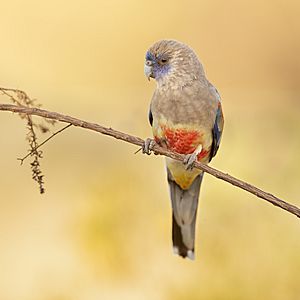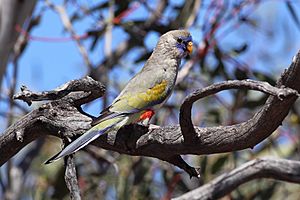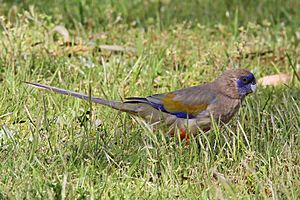Eastern bluebonnet facts for kids
Quick facts for kids Eastern bluebonnet |
|
|---|---|
 |
|
| Conservation status | |
| Scientific classification | |
| Genus: |
Northiella
|
| Species: |
haematogaster
|
The eastern bluebonnet (Northiella haematogaster), also called the greater bluebonnet, is a colorful Australian parrot. It is one of two species in the group called Northiella. This bird was once thought to be part of another parrot group. But scientists noticed it looked and acted differently. So, in 1994, they gave it its own special group.
The bluebonnet is a medium-sized parrot. It lives in the middle parts of southeastern and central-southern Australia. It is good at living in dry areas. But it can also live in places with a bit more rain.
Contents
About the Bluebonnet's Family
Scientists group living things into families. The Eastern bluebonnet was once in a group called Psephotus. But it has its own group now. This is because it looks and acts very differently from other parrots in that old group.
There are three main types, or subspecies, of the Eastern bluebonnet:
- Northiella haematogaster haematorrhous – This one is called the red-vented bluebonnet. It lives in the northeast part of the bluebonnet's home range.
- Northiella haematogaster haematogaster – This is the yellow-vented bluebonnet. You can find it in the central north of the bluebonnet's range.
- Northiella haematogaster pallescens – This one is known as the pallid bluebonnet. It lives in the far northwest of the bluebonnet's home.
Sometimes, these different types of bluebonnets live near each other. When they do, they can mix and have babies together.
What Does a Bluebonnet Look Like?
The Eastern bluebonnet is a medium-sized parrot. It has feathers on its head that look like a small crest. All bluebonnets have an olive-grey to brown color on their upper body. Their neck and chest are also this color. The outer part of their wing is dark blue. Their forehead and face are also blue.
Their beak is a light pearl grey. Their eyes are brown-grey. Their feet and legs are dark grey. Their colors do not change with the seasons. There are no other parrots that look very similar to the bluebonnet.
Here are some average sizes:
- Body length: Males are about 28–35 cm long. Females are about 26–32 cm long.
- Wingspan: Males have a wingspan of 36–42 cm. Females have a wingspan of 34–38 cm.
- Weight: They usually weigh between 70 and 100 grams.
Each type of bluebonnet has slightly different colors and sizes. Most differences are in how much red they have on their belly. Also, the pattern on their inner wing can change. It can be olive-yellow with a blue patch. Or it can be mostly red with a blue-green patch.
Differences in Subspecies
- N. h. haematorrhous: This type has red covering its entire lower belly and under its tail. Its wing has a mostly red patch on the shoulder. The front edge of its wing is a lighter blue-green.
- N. h. haematogaster: Its lower belly is yellow. It has different amounts of red on its stomach. Its wing patch is yellowish-olive.
- N. h. pallescens: This type is paler overall. The color difference between its chest and its pale yellow belly is not as strong.
Male, Female, and Young Birds
- Adult Female: Females look a bit duller than males. They have less red on their belly. Females sometimes have a thin off-white band on the underside of their wing.
- Juvenile (Young Bird): Young bluebonnets look like adult females. But they are a bit duller. They usually have less red on their belly. The most noticeable thing about young birds is their brownish-orange beak. This beak color changes to pearl-grey as they grow. Young birds get their adult feathers when they are about three to four months old.
Bluebonnet Calls
Bluebonnets make different sounds. They have a harsh 'chack chack' call. They also make a flute-like 'cloote' sound. Sometimes, they make a loud 'yak-yak-yak' noise.
Where Bluebonnets Live
Bluebonnets live in the middle parts of southeastern and central-southern Australia. Their home range goes from northern Victoria up to southern Queensland in the east. It stretches across to southeastern Western Australia in the west.
Each type of bluebonnet lives in a specific part of this area:
- N. h. haematorrhous: Lives from southern Queensland to northern New South Wales.
- N. h. haematogaster: Lives in western and southern New South Wales. Also in northwest Victoria to southeast South Australia.
- N. h. pallescens: Lives in inland South Australia, especially around the Lake Eyre Basin.
How They Move Around
Bluebonnets usually stay in one place. They don't travel far for seasons. They might move a little bit locally. But they don't make long journeys.
Where Bluebonnets Make Their Home
Bluebonnets live in dry and semi-dry areas of Australia. They like open woodlands. These woodlands often have trees like false sandalwood, belah, native pine, western myall, gidgee, and mulga. They also like areas with low shrubs. These shrubs can be saltbush or blue bush.
Bluebonnets also live in open grassy plains. They can be found in scrubland. And they like trees near water. Some areas of mallee trees in northern Victoria are also important homes for these birds.
What Bluebonnets Eat
Bluebonnets mostly eat on the ground. They eat seeds from native and introduced grasses. They also eat seeds from other plants, trees, and shrubs. They will also eat fruit, berries, flowers, and nectar. Sometimes, they eat insects and their young. In dry areas, they eat the seeds and fruit of the saltbush plant.
Bluebonnets usually drink water at dawn (sunrise) and dusk (sunset). They are careful when they go to drink.
How Bluebonnets Act Together
Bluebonnets are usually seen in pairs. Or they might be in small groups of less than ten birds. When it's time to breed, pairs will separate in late winter. They will rejoin the larger group in late spring with their young birds.
If something scares them, bluebonnets will quickly fly up. They make whistling sounds as they fly. They will fly to a nearby tree. There, they become quiet. They stand tall to watch what scared them. They wait for a chance to go back to the ground.
Bluebonnets fly with a wavy, sometimes jerky movement. They usually fly below the tops of trees.
How Bluebonnets Have Babies
Bluebonnets usually breed between August and January. But this can start earlier or later if there has been a lot of rain.
During courtship, the male bluebonnet will raise and lower his head feathers. He stretches his neck. He vibrates his partly raised wings. He moves his fanned tail from side to side. Bluebonnets stay with one partner for life. They usually breed once a year. But if there's a lot of rain, they might breed twice.
Both the male and female choose and prepare the nest site. It's often a hollow in a tree trunk or branch. The hole to the nest is usually small. They usually lay four to seven white, oval eggs. These eggs are laid on a layer of old wood dust at the bottom of the nest.
Only the female bird sits on the eggs to keep them warm. The male feeds her during this time. The eggs hatch in about 19 days. The chicks are born covered in white fluff. The female continues to keep the chicks warm by herself. But both parents feed the chicks.
Chicks leave the nest when they are about 30 days old. Their parents continue to feed them for about 12 more days. After that, the young birds can take care of themselves. Then, the family joins the larger group of bluebonnets.
Bluebonnets as Pets
The bluebonnet is quite common in the wild. But it's not often kept as a pet. This is because people sometimes think they are plain-looking. They can also be noisy and very aggressive. They are also not known to be good at breeding in captivity.
See also
 In Spanish: Perico cariazul para niños
In Spanish: Perico cariazul para niños




